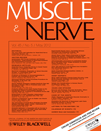The convergence of facial nerve branches providing whisker pad motor supply in rats: Implications for facial reanimation study
Abstract
Introduction:
Rodent whisking behavior is supported by the buccal and mandibular branches of the facial nerve, but a description of how these branches converge and contribute to whisker movement is lacking.
Methods:
Eight rats underwent isolated transection of either the buccal or mandibular branch and subsequent opposite branch transection. Whisking function was analyzed after both transections. Anatomical measurements, and video recording of stimulation to individual branches, were taken from both facial nerves in 10 rats.
Results:
Normal to near-normal whisking was demonstrated after isolated branch transection. Whisking was eliminated after transection of both branches. The buccal and mandibular branches form a convergence just proximal to the whisker pad, herein called “distal pes.” Distal to this convergence, we identified consistent anatomy that demonstrated cross-innervation.
Conclusion:
The overlap of efferent supply to the whisker pad must be considered when studying facial nerve regeneration in the rat facial nerve model. Muscle Nerve, 2012




